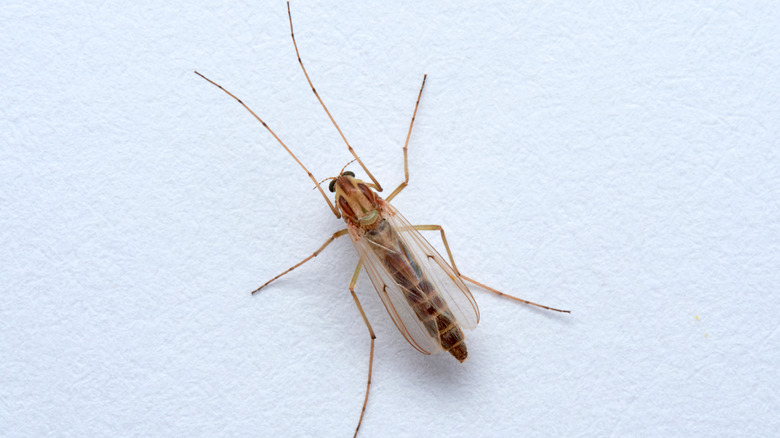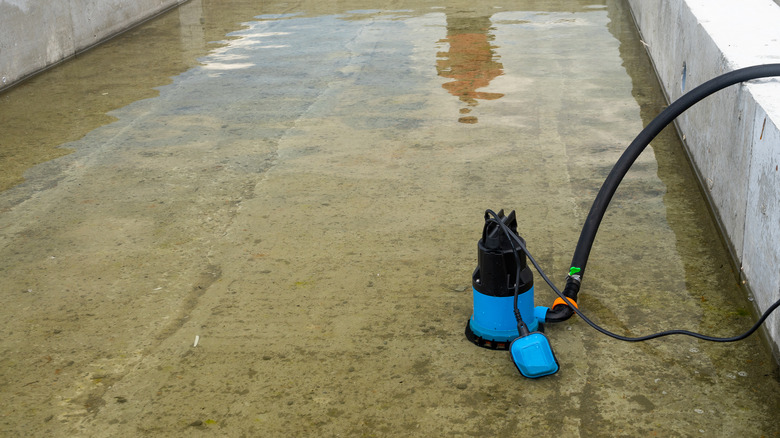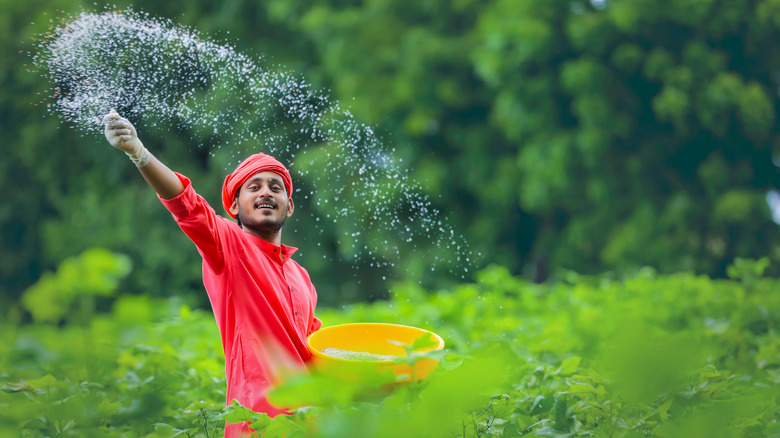7 Best Ways To Get Rid Of Biting Midges
All prices are current as of time of publication. If you click a link and buy a product from a merchant, we may be paid an affiliate commission.
Biting midges (AKA no-see-ums or sandflies) transmit mansonella ozzardi, theEPA reports, a parasite responsible for body cavity filariasis which is symptomized by chronic body swelling, lymphatic damage, and elephantiasis. What the ...
Though male midges don't bite, female midges –- which Smidge Up says arrive at your home in early June and leave in September -– aggressively dig into human and animal skin for the blood meal needed for egg development. SleepDreamz further explains that the sand fly's feeding habit causes skin irritation, itching, infection, plus sleeplessness in humans, or severe dermatitis in horses. "Good lord! So what are midges attracted to in my home? And what are the best ways to get rid of biting no-see-ums for good?" you ask.
Well, according to Cookist, what attracts midges in the house are moisture, warmth, fermented waste products, decomposed or near-decomposed food, and carbon dioxide. Also, if you happen to live close to a swamp or aren't cleaning your gutters properly, you're likely to get visited, Healthy WA reveals. Luckily, these blood-suckers (usually 1 millimeter to 2.5 millimeters in size) live for only 10 to 15 days and can be eliminated completely in seven easy ways. Let's see.
1. Remove stagnant water
The life cycle of a notorious midge starts as a bad egg, then an elusive larva, then a pupa which ends up as an invisible blood-sucking adult. During the mating season in summer, a female can lay as many as 450 eggs, choosing the stagnant or slow-moving water around your home as a breeding ground (via Highland Titles.) So, what gives? Well, this is the best time (summer) to eliminate hundreds of bad eggs before they become full-blown devils.
You can eliminate biting midges in the same way you get rid of mosquitoes in their egg stage: spot and remove surrounding stagnant water. Solutions Stores suggests starting with your swimming pool, dirty pond, neglected artificial waterfall, mud, unused tires, and birdbaths. According to ServiceMaster Restoration, you first evacuate a deeper pool of stagnant water with submersible pumps. After that, clear the remaining water with a wet vacuum and dry out the floor with mops and heavy-duty fans. Finally, prepare a disinfecting solution of 1 gallon of water and 1 cup of bleach to be sprayed for disinfection.
2. Grow plants to get rid of midges
Many indoor and garden plants are natural enemies to the minute, two-winged, mosquito-like fly. Some of them are even known to purify or humidify the air we breathe. What's better? Pest-killing indoor plants are available at your local nursery where they are sold at relatively cheap prices. According to BugWiz, some of the most eco-friendly sand fly killing plants include citronella, marigold, catmint, basil, lavender, and eucalyptus.
Now, you have to be strategic when using these plants to get rid of midges indoors for optimum results. Hayes Garden World suggests putting marigolds near the doorway or close to the windows, peppermint in a shady position, lavender in the lounge, eucalyptus in the BBQ area, basil in the bedrooms, and citronella close to the sun on the window. It is noteworthy that these plants need proper care to thrive and require different conditions such as soil type, light needs, water demands, and so on.
3. Apply home remedies
So, what home remedy gets rid of midges in the house? Let's start with apple cider vinegar. Hunker explains the application procedure: You squeeze 2 drops of liquid dish soap into a glass filled with 1/2 inch of apple cider vinegar and place the cup around windows, doors, and other portals that lead no-see-ums indoors. Sandflies are attracted to the mixture, get stuck on contact, and die struggling. Of course, depending on the number of windows and doors, you need to prepare as many cups as necessary. Of course, once a cup gathers enough flies, the mix should be disposed of and replaced.
Alternatively, no-see-ums detest the smell of pine oil which is why BugWiz suggests soaking pieces of old cloth in pine oil and then hanging those around your home, technically where the midges pass indoors. You can also hang these oil strips in the garage, pet house, patios, and even around the garden for outdoor solutions.
4. Use midge-rated insecticides/repellents
News flash: If you're in Florida, there are over 47 different species of midges around you, a fragment of the over 4,000 species worldwide (via ScienceDirect). And if you happen to live in the U.K., the University Of Cambridge explains that 150 species of the blood-sucking flies are U.K.-based. Unfortunately, most of the home remedies and plants used to get rid of midges don't work on some really tough species — and that's where insecticides come in. They're chemical-based, yes, but they will eliminate those biting thingies regardless of species or stage of growth.
Stop Pest Info reviewed the 10 best repellants and killers of no-see-ums, all of which can be obtained from your home improvement store. To that end, a lot of homeowners who have used SureFire Mosquito & Midge Slayer Insecticide report a drastic reduction in the midgy population (via eBay). In all you do, make sure to apply your insecticides as instructed, and remember to use your PPE (personal protective equipment) before working with any chemical substance.
5. Curb fertilizer usage
Earlier on, we explained that no-see-ums are attracted to nutrients in decomposed wastes, warmth, and moisture. All of these three and more are present in abundance in both fertilizer and organic manure used for the promotion of plant growth in farms and gardens. So, if you happen to be a weekend farmer or a hobbyist gardener, you better cut back on fertilizer usage in order to get rid of midges.
Killem Pest explains that excessive application causes fertilizer to run off and sip through the soil, landing in nearby water bodies, which are mostly stagnant ponds and streams where hundreds of midges/eggs/larvae get nourishment. To that end, Scientific American stresses the adoption of controlled-release fertilizer that is more environmentally friendly, inexpensive, curbs the release of excessive nutrients, and promotes crop yields. Additionally, Vegetable Growers News lists five ways to reduce fertilizer use, which we believe are worth adding to your fertilizer and manure management plan.
6. Prevent indoor midge movement and growth
An unhygienic kitchen is a major midge target, especially if you're not cleaning your kitchen cabinets properly. No-see-ums enjoy juice with a high sugar content (mostly fermented oranges), fluid from steak or fish waste, overripe potatoes or tomatoes, and other food items that go bad quickly as listed on Eat This, Not That. Instead of inviting biting flies with spoiled food, Woman's Day shares 12 smart ways to prevent food from going to waste.
Now, having prevented midgy growth in your kitchen and committing to a cleaning routine to keep your home free of stagnant water, Cleanipedia emphasizes the need to stop midges from coming in by installing screens on doors and windows. We recommend going for Midge Screens that are specifically designed to keep no-see-ums out. Finally, these blood-suckers are attracted to body sweat, heat, and smell so it's important to also include proper body and clothing hygiene in your goals to say goodbye to midges for good.
7. Seek help from professional
Biting sandflies are elusive, so much so that you can easily miss a family of them during treatment. This is why we recommend letting professional pest controllers do the job for you. Besides, Killem Pest writes, there are cases of these insects living behind drywall where you can hardly eliminate them without destroying your household items. Other cases that call for the employment of professional midge exterminators include indoor mass invasion and when your property is attacked by a swam.
Anyway, before purchasing a service from pest control experts, do your research, and get your answers to know if they can be trusted to convert your home from midge-infested to 100% midge-free. First, you need to make sure they have a physical location (use Google Maps for this). Next, ask if they do midge removal/extermination. If so, go to a popular review community like Trustpilot to know the kind of experience that previous clients have had with the company. Finally, if they seem to be good for the job, book a call to discuss the situation with them.







